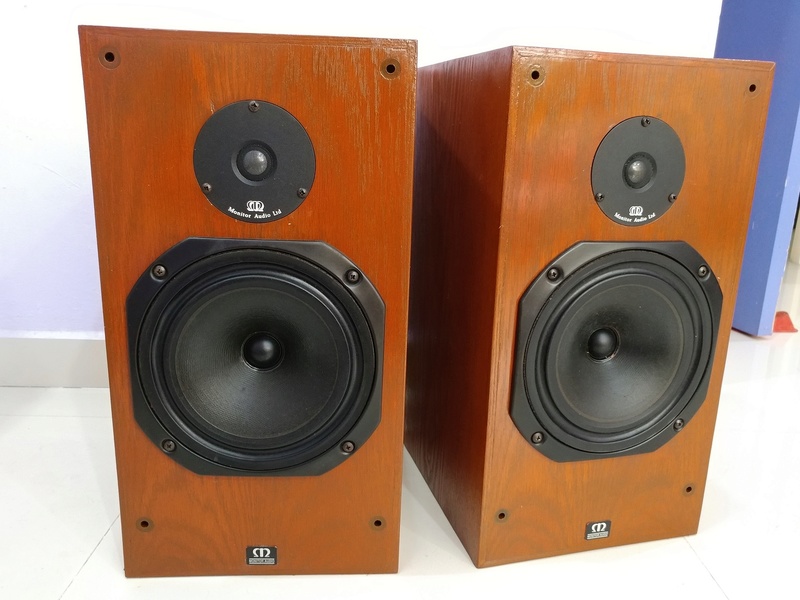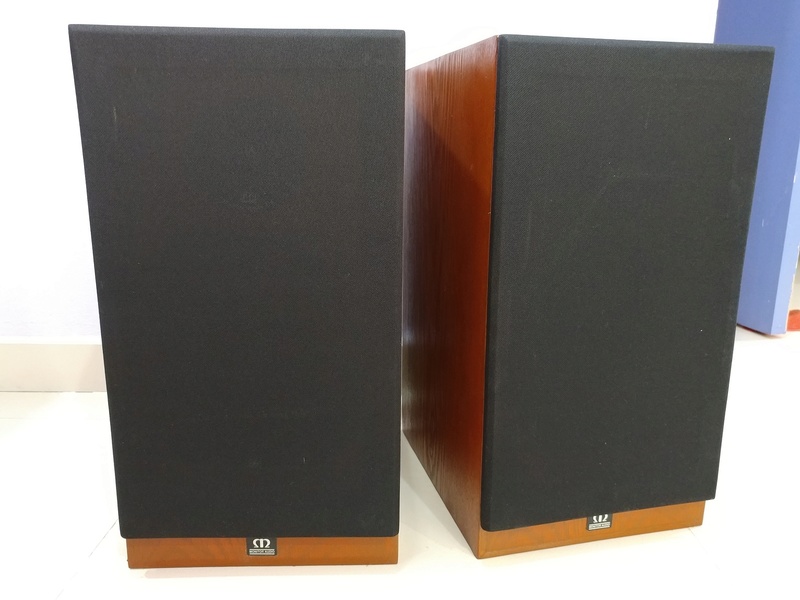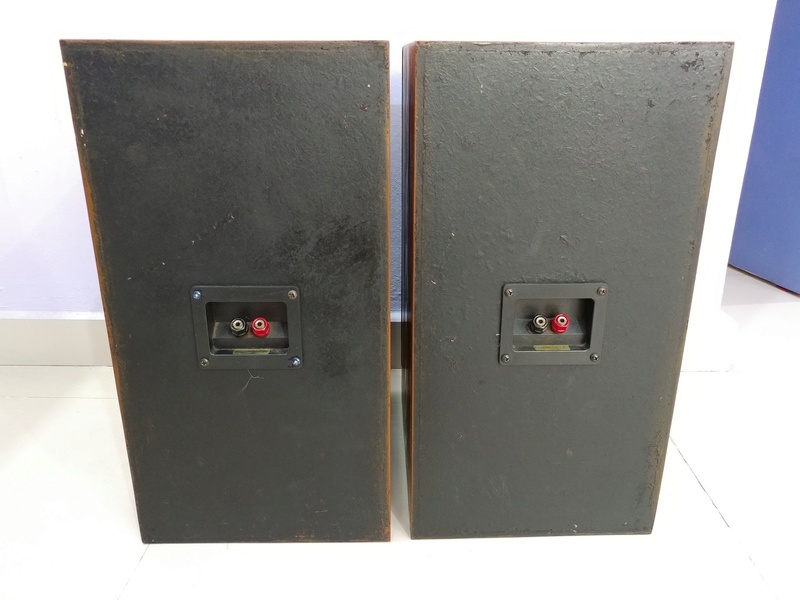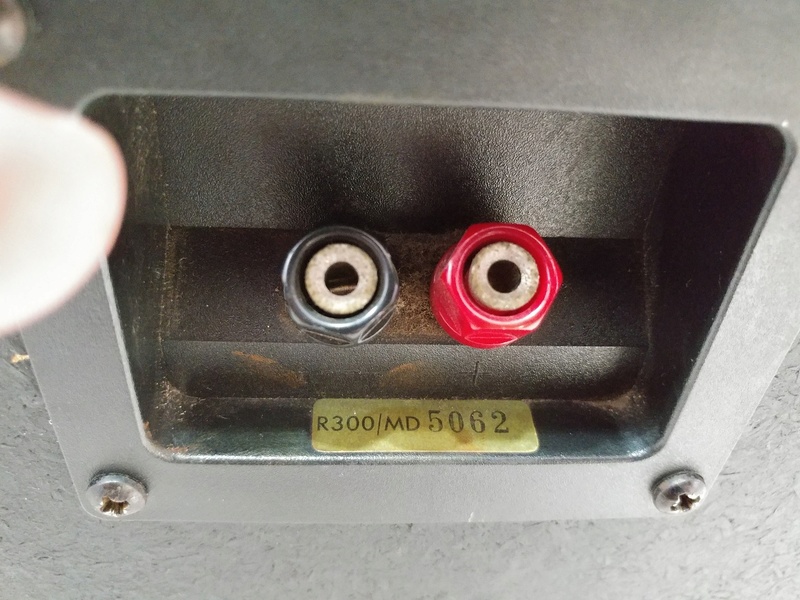Monitor Audio R-300 /MD England Stand-Mount Bookshelf Speaker
Hi-Fi 4 Sale - Malaysia / Singapore Audio Forum & Marketplace | www.hifi4sale.net :: Audio & Video Equipment Marketplace :: Audio & Video Equipment: FOR SALE (Pre-owned & Used)
Page 1 of 1
 Monitor Audio R-300 /MD England Stand-Mount Bookshelf Speaker
Monitor Audio R-300 /MD England Stand-Mount Bookshelf Speaker







Made In England
Monitor Audio has a great reputation for hand built Audiophile quality speakers and these don't disappoint in the right setup.
These Monitor Audio R300-MD (metal dome) speakers were designed by Robin Marshall as an upgrade to the Monitor Audio R252.
Monitor Audio R300 oldies but goodies,
8" bass plus 1" tweeter, which is a tricky combination.
They are a sealed box setup with no bass port and a large cabinet size - 47X25X30 cm
This produces a punchy bass instead of a boomy one - perfect for those who love vinyl and are running a warm sounding amp.
Plenty of detail in the top end and a full midrange
The sound is really beautiful, as you would expect from speakers of this quality. Please be aware of the size: the cabinets measure 470mm high by 250mm wide by 320 deep, and weight 14kg each.
fantastically crisp top end and a solid low end ( amazing presence )
Description:
- Two-way, sealed-box, stand-mounted loudspeaker.
Drive-units:
0.75" metal-dome tweeter,
8" doped paper-cone woofer.
Crossover frequency: 4.2kHz.
Frequency response: 50Hz–20kHz ±3dB.
Sensitivity: 90dB/W/m.
Nominal impedance: 8 ohms.
Amplifier requirements: 15–100W.
Dimensions: 18.5" H by 12.5" W by 10" D.
Weight: 22 lbs each.
The Monitor Audio R300/MD debuted at the 1988 SCES in Chicago.
English company Monitor Audio is one of the pioneers in spreading the use of metal-dome tweeters in relatively low-cost loudspeaker systems.
The tweeters they have designed in conjunction with SEAS and British manufacturer Elac may have now found their ways into a number of designs from competing manufacturers, but there is no doubt that Monitor leads the way.
The R300/MD features a new ¾" version of the SEAS 1" aluminum-dome unit Monitor introduced with their R652/MD (reviewed in Vol.10 No.5), in conjunction with an 8" doped paper-cone woofer.
In the past, I have been accused of an irrational prejudice for metal domes over soft domes, and there appears to be some confusion among audiophiles over what benefits are conferred by the use of a good metal-dome tweeter. (I have to say "good" as there are some bad ones, particularly those in which a metal layer has been vapor-deposited on a plastic substrate.)
With any drive-unit, it is ideally required that the diaphragm operate as a whole in its passband, not going into break-up where some parts of the surface go forward while others go backward.
There are two philosophies in tweeter design that attempt to achieve this ideal. The first, and most common, is to recognize that break-up is inevitable, allow it to happen, but fashion the diaphragm from some lossy, well-damped material so that any resonant peak will be damped into inaudibility.
Such "soft-dome" tweeters vary considerably in the success with they achieve this goal. Often, they have some kind of resonant behavior in the presence region where the ear is most sensitive, resulting in a noticeable fizz or sizzle to the sound.
It might be thought that the material's inherent damping of this resonance would render it inaudible.
Unfortunately, however, unless extreme, damping may reduce the height of the resonant peak, but therefore also tends to increase the area under the curve, making any reduction in audibility less than might be expected. (It can happen that adding damping to a very-high–Q resonance will make it more audible because it makes the resonance more likely to be excited by typical music program.) In addition, soft tweeters quite often have some kind of resonant peak in the 12–16kHz region, which adds, in the worst case, almost a "whistle" to the music. Invariably, in my experience, the soft-dome tweeters that suffer least from these problems are expensive.
The second philosophy is to form the diaphragm out of some very light, very stiff material. A metal of some kind is the obvious choice, but fiberglass, woven Kevlar, and resin-impregnated cloth are also popular. Here, the idea is to push the inevitable resonance way above the audio band, so that even if it is excited, it will not be audible. The dome will then act as a piston throughout the top of the audio band. The disadvantage of such an approach is that it is hard to make the moving parts of the driver light enough. If too massy, not only will be the main resonant frequency be moved down into the audio band, but the sensitivity will also be too low to be practical. Making the dome smaller than usual will lower the mass, but the power-handling may well suffer and the smaller radiating area makes the tweeter less able to handle frequencies in the low treble, necessitating a higher crossover frequency.
In my opinion, a good metal-dome unit will always be more transparent in the treble than a comparable soft-dome driver, adding significantly less presence-band "sizzle" to the sound. However, less good metal-dome units seem to have a "tinkly" signature which, I imagine, is due to the excessive amplitude of the driver's ultrasonic resonance leading to non-linearity and the dumping of intermodulation products back down in the audible region. Faced with a good soft-dome tweeter, such as the Dynaudio used in the Thiel CS3.5, I have no problem with its sound. But give me a speaker with, say, the infamous and ubiquitous 1" fabric-dome unit from Son-Audax, and I tend to leave the room, driven out by "soft-dome sizzle." Prejudiced? No, more a case of "Heaven preserve me from nasty, cheap tweeters!"
As usual with Monitor Audio models, the R300 enclosure, including the front baffle, is veneered in real wood—the review samples were finished in walnut—with all interior surfaces except the rear panel also veneered. This is said to increase cabinet rigidity; there are also vertical braces running the entire height of the side walls. The internal surfaces are covered with a layer of polyurethane foam to damp internal air-space resonant modes. The enclosure is relatively large for the price, though the fact that it is fairly deep gives the R300s quite a small visual profile.
Of the drive-units, only the tweeter, which uses a very short horn flare to load the dome, is rebated into the baffle. The woofer chassis, however, is profiled to minimize its acoustic discontinuity. As with other current MA speakers, the crossover, which is attached to the rear of the terminal panel, is minimal. It consists of a ferrite-cored coil in series with the woofer and a second-order high-pass network, basically a series capacitor and a parallel air-cored inductor, for the tweeter. A series resistor is also used to match the tweeter sensitivity to that of the woofer. Electrical connection is via five-way binding posts.
The Sound
With the R300/MDs initially set up on 17" Hercules stands, it became quickly obvious that the listening height was too low, a notch in the low treble being audible. The metal Arcici "Rigid Riser" metal stands, set to their 20" height, were therefore pressed into service and proved to be a good match with the R300s, placing the tweeter at ear level. The grilles are profiled in the tweeter region to minimize diffraction/reflection problems, so although the speakers do look finished au naturel, I listened to the speakers with the grilles on.
On pink noise, the R300 had an overall smooth, even character to its balance, but with slight prominences in the midrange and mid-treble lending a "two-humped," slightly hollow-sounding nature. This was limited in degree, however. Moving on to music program—do you know anyone who listens to noise for enjoyment?—and starting at the lowest frequencies, the bass was light in weight considering my expectations from the cabinet size, though the upper bass was more generous. Nevertheless, this is not a speaker for organ enthusiasts. Double-basses had rather a gruff character, with less distinct pitch centers than, for example, Monitor Audio's own R952/MD. Cellos also took an added warmth in their lower region, as did male voice, while the left-hand register of the piano had a little too much overhang, notes acquiring a "hoom" quality. (Try murmuring the word "hoom" while you play a bass piano note and you'll get the idea.)
Moving up into the midrange, things were considerably improved, with an open, transparent nature evident. Perhaps a little forward in balance, the R300 still allowed the different tonal identities of violin (in its lower register) and viola to be well-differentiated. Female voice, too, was reproduced with a natural balance between chest and throat tones, though a touch of nasality was occasionally noticeable.
The highs were also clean, percussion instruments being reproduced with the full range of differences apparent, suggesting an overall low level of resonant nasties. There was some liveliness at the top of the woofer's range noticeable on piano sound, however, though this was mild in comparison with many other speakers in the '300's price range. The final octave of treble could be heard to be a little rolled-off on naturally miked orchestral recordings, though this did usefully tame the brightest rock recordings, Dire Straits' Brothers in Arms, for example. (But if I have to hear "Walk of Life" even one more time, there will be violence chez Atkinson! It'll be Silver Frisbee time.)
It was in the region of imaging that the R300/MD excelled, considering that it's basically an inexpensive speaker. Though the stage was a little narrow in the lower midrange and below, above that region the speakers threw a quite well-defined, wide soundstage, with individual instrumental and vocal images set back pretty much the right degree of depth, depending on the amount of recorded reverberation associated with each. The Steinway on my Chopin recording on the HFN/RR Test CD, for example, was reproduced with its soundboard extending from just left of center to the right-hand speaker position, set back behind the plane of the speakers—just as it should be reproduced. There was less depth apparent in the treble, however, the hi-hat cymbal on the HFN/RR CD's naturally miked drum recording being somewhat pushed forward at the listener. While not quite as holographic, therefore, as the similarly priced LS3/5a, DELAC S10, or Spica TC-50, the R300/MD still performs very creditably in this region, and will be much more proletarian in its demands for high-quality amplification.
Conclusion
"Competent rather than outstanding," read my listening notes for the R300/MD. But wait a Mo'(footnote 2)—we're talking about a $669 pair of speakers here, not some cost-no-object fantasy object! An easy high Class D recommendation, the Monitor Audio R300/MD strikes an excellent balance between tonal neutrality, the ability to play loudly and cleanly, and the power to resolve a deep, detailed soundstage. Faults are minor, mainly involving the gruff, rather indistinct nature of the upper bass, and the veiled quality to the lower midrange. Its high sensitivity, easy impedance load, and general lack of high-frequency nasties should enable its users to get the best from inexpensive electronics. With the R300/MD offering this kind of performance for well under a kilobuck, as well as being a very attractive piece of furniture in its own real-wood–veneered right, I am sure that designers for competing affordable-speaker manufacturers will be asked to put in some overtime at their CAD workstations real soon now.
Price : RM 1750
Contact Simon Ting 012-3612507
HiFiLab- Dealer\Reseller\Trader\Service Provider

- Number of posts : 2971
Age : 45
Location : klang
Registration date : 2011-03-12
Character sheet
Source(s):
Amplification:
Speakers:
 BUMP
BUMP
UP
HiFiLab- Dealer\Reseller\Trader\Service Provider

- Number of posts : 2971
Age : 45
Location : klang
Registration date : 2011-03-12
Character sheet
Source(s):
Amplification:
Speakers:
 Similar topics
Similar topics» Kef 303 Series II England Vintage Stereo stand mount bookshelf speaker
» Monitor Audio R300MD England Made Standmount Bookshelf Speaker Designed by Robin Marshall
» PSB Image B-25 Canada stereo Stand mount bookshelf speaker
» CREEK CL20 British Stand Mount Bookshelf Speaker
» Audio Note AX two stand mount speaker RM2800
» Monitor Audio R300MD England Made Standmount Bookshelf Speaker Designed by Robin Marshall
» PSB Image B-25 Canada stereo Stand mount bookshelf speaker
» CREEK CL20 British Stand Mount Bookshelf Speaker
» Audio Note AX two stand mount speaker RM2800
Hi-Fi 4 Sale - Malaysia / Singapore Audio Forum & Marketplace | www.hifi4sale.net :: Audio & Video Equipment Marketplace :: Audio & Video Equipment: FOR SALE (Pre-owned & Used)
Page 1 of 1
Permissions in this forum:
You cannot reply to topics in this forum








